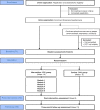Living with Loss: study protocol for a randomized controlled trial evaluating an internet-based perinatal bereavement program for parents following stillbirth and neonatal death
- PMID: 35668502
- PMCID: PMC9167910
- DOI: 10.1186/s13063-022-06363-0
Living with Loss: study protocol for a randomized controlled trial evaluating an internet-based perinatal bereavement program for parents following stillbirth and neonatal death
Abstract
Background: Stillbirth and neonatal death are devastating pregnancy outcomes with long-lasting psychosocial consequences for parents and families, and wide-ranging economic impacts on health systems and society. It is essential that parents and families have access to appropriate support, yet services are often limited. Internet-based programs may provide another option of psychosocial support for parents following the death of a baby. We aim to evaluate the efficacy and acceptability of a self-guided internet-based perinatal bereavement support program "Living with Loss" (LWL) in reducing psychological distress and improving the wellbeing of parents following stillbirth or neonatal death.
Methods: This trial is a two-arm parallel group randomized controlled trial comparing the intervention arm (LWL) with a care as usual control arm (CAU). We anticipate recruiting 150 women and men across Australia who have experienced a stillbirth or neonatal death in the past 2 years. Participants randomized to the LWL group will receive the six-module internet-based program over 8 weeks including automated email notifications and reminders. Baseline, post-intervention, and 3-month follow-up assessments will be conducted to assess primary and secondary outcomes for both arms. The primary outcome will be the change in Kessler Psychological Distress Scale (K10) scores from baseline to 3-month follow-up. Secondary outcomes include perinatal grief, anxiety, depression, quality of life, program satisfaction and acceptability, and cost-effectiveness. Analysis will use intention-to-treat linear mixed models to examine psychological distress symptom scores at 3-month follow-up. Subgroup analyses by severity of symptoms at baseline will be undertaken.
Discussion: The LWL program aims to provide an evidence-based accessible and flexible support option for bereaved parents following stillbirth or neonatal death. This may be particularly useful for parents and healthcare professionals residing in rural regions where services and supports are limited. This RCT seeks to provide evidence of the efficacy, acceptability, and cost-effectiveness of the LWL program and contribute to our understanding of the role digital services may play in addressing the gap in the availability of specific bereavement support resources for parents following the death of a baby, particularly for men.
Trial registration: Australian New Zealand Clinical Trials Registry, ACTRN12621000631808 . Registered prospectively on 27 May 2021.
Keywords: Anxiety; Bereavement; Distress; Grief; Internet; Neonatal death; Online; Perinatal; Pregnancy loss; Stillbirth.
© 2022. The Author(s).
Conflict of interest statement
The authors declare that they currently have no competing interests.
Figures
Similar articles
-
The perinatal bereavement project: development and evaluation of supportive guidelines for families experiencing stillbirth and neonatal death in Southeast Brazil-a quasi-experimental before-and-after study.Reprod Health. 2021 Jan 6;18(1):5. doi: 10.1186/s12978-020-01040-4. Reprod Health. 2021. PMID: 33407643 Free PMC article.
-
Economic evaluation of a randomised controlled trial - An online bereavement support program for parents following perinatal death.Women Birth. 2025 Jul;38(4):101933. doi: 10.1016/j.wombi.2025.101933. Epub 2025 Jun 2. Women Birth. 2025. PMID: 40460694 Clinical Trial.
-
Preliminary findings on the experiences of care for parents who suffered perinatal bereavement during the COVID-19 pandemic.BMC Pregnancy Childbirth. 2021 Dec 22;21(1):840. doi: 10.1186/s12884-021-04292-5. BMC Pregnancy Childbirth. 2021. PMID: 34937548 Free PMC article.
-
Parents experiences of pregnancy following perinatal loss: An integrative review.Midwifery. 2023 Jun;121:103673. doi: 10.1016/j.midw.2023.103673. Epub 2023 Mar 30. Midwifery. 2023. PMID: 37037073 Review.
-
Advancing care and support for women and families after stillbirth or neonatal death in Kenya and Uganda: a feasibility study.Southampton (UK): National Institute for Health and Care Research; 2024 Sep 25. Southampton (UK): National Institute for Health and Care Research; 2024 Sep 25. PMID: 39808016 Free Books & Documents. Review.
Cited by
-
Support for parents and families after stillbirth and neonatal death.Cochrane Database Syst Rev. 2024 Nov 13;11(11):CD015798. doi: 10.1002/14651858.CD015798. Cochrane Database Syst Rev. 2024. PMID: 39535308 Free PMC article.
-
Midwives' support for parents following stillbirth: How they practise and resources they need from a phenomenological perspective.J Adv Nurs. 2025 Mar;81(3):1554-1567. doi: 10.1111/jan.16385. Epub 2024 Aug 11. J Adv Nurs. 2025. PMID: 39129238 Free PMC article.
References
-
- Australian Institute of Health and Welfare. Stillbirths and neonatal deaths in Australia 2015 and 2016: in brief. Perinatal statistics series no. 36. Cat. No. PER 102. Canberra: AIHW; 2019. Available from: https://www.aihw.gov.au/getmedia/12d0156d-b343-403f-ab62-8700861edeca/ai.... Cited March 2022.
Publication types
MeSH terms
LinkOut - more resources
Full Text Sources
Medical
Research Materials
Miscellaneous


